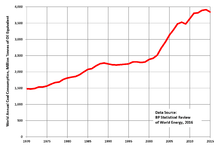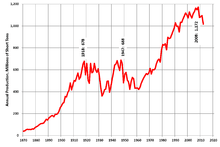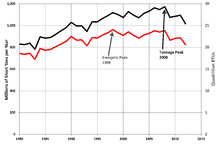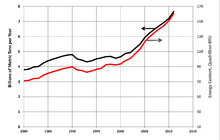Peak coal
Peak coal is a concept describing the peak consumption or production of coal by a human community. As of 2020, the global coal peak consumption was 2013.[1] The peak of coal's share in the global energy mix was in 2008, when coal accounted for 30% of global energy production.[1] The decline in coal use is largely driven by consumption decline in the United States and Europe, as well as developed economies in Asia.[1]
Peak coal can be driven by peak demand or peak supply. Historically, it was widely believed that the supply-side would eventually drive peak coal due to the depletion of coal reserves. However, since the increasing global efforts to limit climate change, peak coal has been driven by demand, which has stayed below the 2013 peak consumption.[1] This is due in large part due to the rapid expansion of natural gas and renewable energy.[1] Many countries have pledged to phase-out coal, while coal reserves are estimated to last for centuries at current consumption levels. In some countries coal consumption is still increasing, including countries in Africa and Latin America, as well as major producers and consumers, China and India.[1]
Peak coal demand


Although reserves of coal remain abundant, consumption of coal has declined in many countries. In 2016, Scotland closed its last coal-fired power plant.[2] This decline has resulted from the replacement of coal-fired electricity by gas and renewable energy, along with the decline of the steel industry in some countries. As a result, the term "peak coal" is now used primarily to refer to a peak and subsequent decline in global and national coal consumption. In 2016 experts estimated that China, the world's largest coal consumer, reached peak coal in 2013, and that the world may have passed peak coal.[3] However, in 2017, for the first time in four years, demand for coal rose.[4]
As of 2015, China accounted for 50.0 percent of world coal consumption. Chinese coal consumption fell in 2014 and 2015. The last previous decline in Chinese coal consumption had been in 1997 and 1998. While consumption in China and the United States declined in 2015, that of India continued to rise and, in 2015, India surpassed the United States and became the world's second-largest consumer of coal.[5]
Peak coal production for individual nations

As of 2018, the top coal-extracting countries were China (46.0%), India (9.5%), US (8.6%), Indonesia (6.8%), Australia (6.1%)
China
China mines the most out of the countries that produce coal and has the third largest reserves after Russia and the United States. The Energy Watch Group predicted that the Chinese extraction will peak around 2015 in their 2007 report, and then revised that to 2020 in their March 2013 report.[6]:27[7] The EWG also predicts that the recent steep rise in extraction will be followed by a steep decline after 2020. Another study puts the peak at 2027.[8] The US Energy Information Administration projects that China coal extraction will continue to rise until 2030.[9]
India
In 2018 India was the world's second largest coal producer, but it may peak in the 2020s.[10]
United States


Although Hubbert's analysis in 1956 projected total extraction to peak in about 2150,[11] records show that extraction reached an energy peak in 1998 and a tonnage peak in 2008.[12]
Coal mass
US coal extraction peaked during World War I, then declined sharply during the depression years of the 1930s. Coal extraction peaked again in the 1940s, then declined during the 1950s.[11] Then coal extraction revived, and was on a nearly continual increasing trend from 1962 to 2008, exceeding the previous peaks. Extraction in 2008 was a record 1.17 billion short tons.[13] High-BTU anthracite coal peaked in 1914;[11] and declined from 44 million tons in 1950 to 1.6 million tons in 2007. Bituminous coal extraction has also been declining since 1990. The gap has been taken up by large increases in subbituminous coal extraction.[13] Comprehensive analysis of historical trends in US coal extraction and reserve estimates, along with a possible future outlook, was published in scientific journals on coal geology in 2009.[14]
In 1956, Hubbert estimated that US coal extraction would peak in about the year 2150.[11] In 2004, Gregson Vaux used the Hubbert model to predict peak US coal extraction in 2032.[15] In 2014, a model published in the International Journal of Coal Geology forecast a U.S. raw tonnage peak from between 2009 and 2023, with the most likely year of the peak in 2010.[16]
Energetic peak
Over the years, the average energy content per ton of coal mined in the US has declined as mining shifts to coals of lower rank. Although the tonnage of coal mined in the United States reached its latest peak in 2008, the peak in terms of coal energy content occurred in 1998, at 598 Millions of metric tons of oil equivalent (Mtoe); by 2005 this had fallen to 576 Mtoe, or about 4% lower.[6][17]
Australia
Australia has substantial coal resources, mostly brown coal. It is responsible for almost 40% of global coal exports worldwide, and much of its current electricity is generated from coal-fired power stations. There are tentative plans to very slowly phase out coal electricity generation in favor of gas, although these plans are still a topic of much debate in Australian politics. Groups such as the Australian Greens, suggest that coal be left in the ground to avoid its potential combustion either in Australia or in importer nations.
Research in 2009, by the University of Newcastle in Australia concluded that Australian coal extraction could peak sometime after 2050.[18] While the Australian Coal Association (ACA) optimistically estimated that Australia's identified black coal resources could last more than 200 years based on rate of extraction in 2007. This does not account for brown coal stocks.[19]
New South Wales
According to calculations conducted for the Hunter Community Environment Centre in Newcastle, the Australian state of New South Wales 10,600 million tonnes of coal reserves would be exhausted by 2042, based on current industry growth and extraction rates of about 3.2 per cent a year.[19]
Indonesia
Government policy is unclear.[20]
United Kingdom
Coal output peaked in 1913 in Britain at 287 Mt and now accounts for less than one percent of world coal extraction. 2007 extraction was around 15 Mt.[21]
Germany
Germany hit peak hard coal extraction in 1958 at 150 million tons. In 2005, hard coal extraction was around 25 million tons.[6] Total coal extraction peaked in 1985 at 578 million short tons, declined sharply in the early 1990s following German reunification, and has been nearly steady since 1999. Total coal extraction in 2005 was 229 million short tons, four percent of total world extraction.[22]
World peak coal


2011 Patzek and Croft
In 2010, Tadeusz Patzek (chairman of the Department of Petroleum and Geosystems Engineering at the University of Texas at Austin) and Greg Croft, predicted that coal production would peak in 2011 or shortly thereafter, and decline so quickly as to nearly eliminate the contribution of coal to climate change. Patzek said: "Our ability to produce this resource at 8 billion tons per year, in my mind, is a dream,"[23] However, world coal production exceeded 8 billion tons per year in 2012 (8.2 billion), 2013 (8.19 billion), and 2014 (8.085 billion).[24]
2150 M. King Hubbert
M. King Hubbert's 1956 projections from the world extraction curve estimated that world coal production would peak at approximately six billion metric tons per year at about the year 2150.[25]
2020 Energy Watch Group
Coal: Resources and Future Production,[6] published on 5 April 2007 by the Energy Watch Group (EWG) found that global coal extraction could peak in as few as 15 years.[26] However, the graphs in their 2013 report show a peak in 2020.[7] Reporting on this, Richard Heinberg also notes that the date of peak annual energetic extraction from coal will likely come earlier than the date of peak in quantity of coal (tons per year) extracted as the most energy-dense types of coal have been mined most extensively.[27]
Institute for Energy
The Future of Coal by B. Kavalov and S. D. Peteves of the Institute for Energy (IFE), prepared for European Commission Joint Research Centre, reached conclusions similar to those of Energy Watch Group, and stated that "coal might not be so abundant, widely available and reliable as an energy source in the future".[26] Kavalov and Peteves did not attempt to forecast a peak in extraction.
US Energy Information Administration
The US Energy Information Administration projects world coal consumption to increase through 2035.[28]
Hubbert's theory
According to M. King Hubbert's Hubbert peak theory, peak coal is the point at which the maximum global coal production rate is reached, after which, according to the theory, the rate of production will enter a terminal decline. Coal is a fossil fuel formed from plant matter over the course of millions of years. It is a finite resource and thus considered to be a non-renewable energy source.
There are two different possible peaks: one measured by mass (i.e. metric tons) and another by energy output (i.e. petajoules). The world average heat content per mass of mined coal rose from 8,020 BTU/lb. in 1989 to 9,060 BTU/lb. in 1999. Since 1999, the world average heat content of mined coal has been fairly steady, and was 9,030 BTU/lb. in 2011.[29]
The estimates for global peak coal extraction vary wildly. Many coal associations suggest the peak could occur in 200 years or more, while scholarly estimates predict the peak to occur as soon as the immediate future. Research in 2009 by the University of Newcastle in Australia concluded that global coal extraction could peak sometime between the present and 2048.[18] A 2007 study by the German Energy Watch Group predicted that global peak coal extraction may occur sometime around 2025 at 30 percent above the 2005 rate.[6][30]
The contemporary concept of peak coal follows from Hubbert peak theory, which is most commonly associated with peak oil. Hubbert concluded that each oil region and nation has a bell-shaped depletion curve.[11] However, this question was originally raised by William Stanley Jevons in his book The Coal Question in 1865.
Hubbert noted that United States coal extraction grew exponentially at a steady 6.6% per year from 1850 to 1910. Then the growth leveled off. He concluded that no finite resource could sustain exponential growth. At some point, the rate of extraction will have to peak and then decline until the resource is exhausted. He theorized that extraction rate plotted versus time would show a bell-shaped curve, declining as rapidly as it had risen.[31] Hubbert used his observation of the US coal extraction to predict the behavior of peak oil.
The Hubbert linearization using yearly production rates has weaknesses for peak coal calculation, as the signal-to-noise ratio is inferior with coal mining data compared to oil extraction. As a consequence, Rutledge[32] uses cumulative production for linearization. By this method the estimated ultimate recovery results in a stable fit for active coal regions. The ultimate production for world coal is estimated to be 680 Gt, of which 309 Gt have already been produced. However, in 2015 the World Coal Association reported that two different estimates of coal reserves remaining were 968 Gt (IEA/BGR) and 891 Gt (BP/WEC).[33]
See also
- Coal phase out
- Hubbert peak theory
- Peak gas
- Peak oil
- Peak uranium
- Peak water
References
- Rapier, Robert. "Coal Demand Rises, But Remains Below Peak Levels". Forbes. Retrieved 14 July 2020.
- "Scotland closes last coal plant".
- "Global coal peak 2013".
- "The world is losing the war against climate change". 2 August 2018. Retrieved 6 August 2018.
- BP Annual Statistical Review of World Energy, 2016.
- "Coal: Resources And Future Production" (PDF). Energy Watch Group. 10 July 2007. Archived from the original (PDF) on 18 May 2015. Retrieved 20 August 2010.
- "Fossil and Nuclear Fuels – the Supply Outlook" (PDF). Energy Watch Group. March 2013. Archived from the original (PDF) on 2 November 2014. Retrieved 3 November 2016.
- "The Oil Drum - Peak Coal and China".
- "International Energy Outlook 2008" (PDF). US Energy Information Administration. p. 52. Retrieved 24 January 2009.
- "Coronavirus lockdown speeds India's shift from coal to solar power". Climate Home News. 7 May 2020. Retrieved 12 July 2020.
- M. King Hubbert (June 1956). "Nuclear Energy and the Fossil Fuels 'Drilling and Production Practice'" (PDF). API. p. 36. Archived from the original (PDF) on 27 May 2008. Retrieved 18 April 2008.
- "US EIA".
- US Energy Information Agency: Coal production, selected years, 1949-2007
- Höök, Mikael; Aleklett, Kjell (2009). "Historical trends in American coal production and a possible future outlook" (PDF). International Journal of Coal Geology. Archived from the original (PDF) on 5 November 2010.
- Gregson Vaux (27 May 2004). "The Peak in U.S. Coal Production". From the Wilderness. Archived from the original on 8 October 2009. Retrieved 30 June 2008.
- Reaver, Nathan G.F.; Khare, Sanjay V. (September 2014). "Imminence of peak in US coal production and overestimation of reserves". International Journal of Coal Geology. 131: 90–105. doi:10.1016/j.coal.2014.05.013.
- Heinberg, Richard (21 May 2007). "Peak coal: sooner than you think". EnergyBulletin.net.
- "Research forecasts world coal production could peak as soon as 2010". The University of Newcastle, Australia. 28 October 2009.
- "Reserves to dry up as clean coal becomes viable". The Sydney Morning Herald. 10 April 2007.
- "Indonesia's president signals a transition away from coal power". Mongabay Environmental News. 16 July 2019. Retrieved 12 July 2020.
- David Strahan (5 March 2008). "Lump sums". London: The Guardian. Retrieved 9 June 2008.
- "World coal production". US Energy Information Agency.
- Patrick Reis, "Study: World's 'Peak Coal' Moment Has Arrived", New York Times, 29 Sept. 2010.
- World Mineral Production 2010-14, British Geological Survey, 2016.
- M. King Hubbert (June 1956). "Nuclear Energy and the Fossil Fuels 'Drilling and Production Practice'" (PDF). API. p. 21. Archived from the original (PDF) on 27 May 2008. Retrieved 18 April 2008.
- Richard Heinberg (21 May 2007). "Peak coal: sooner than you think". Energy Bulletin. Archived from the original on 22 May 2008. Retrieved 6 June 2008.
- Richard Heinberg (March 2007). "burn the furniture". Richard Heinberg. Retrieved 6 June 2008.
- US Energy Information Administration. "International Energy Outlook 2011". Retrieved 29 January 2013.
- US EIA, International Energy Statistics, accessed 16 May 2015.
- "Uranium Resources and Nuclear Energy" (PDF). Energy Watch Group. December 2006. Archived from the original (PDF) on 18 May 2015. Retrieved 22 May 2015.
- M. King Hubbert (June 1956). "Nuclear Energy and the Fossil Fuels 'Drilling and Production Practice'" (PDF). API. p. 8. Archived from the original (PDF) on 27 May 2008. Retrieved 18 April 2008.
- David Rutledge (January 2011). "Estimating long-term world coal production with logit and probit transforms". International Journal of Coal Geology. 85 (1): 23–33. doi:10.1016/j.coal.2010.10.012.
- "Coal Facts 2015" (PDF). World Coal Association. 31 March 2016. Retrieved 7 June 2020.
Further reading
- "Statistical Review of World Energy 2008". Beyond Petroleum. Archived from the original on 22 August 2009. Retrieved 16 June 2008.
- "Coal Data, Reports, Analysis". US Energy Information Administration. Retrieved 16 June 2008.
- "McCloskey's Coal Report". McCloskey Coal. Retrieved 16 June 2008.
- "Energy Export Databrowser". Mazama Science. Retrieved 25 March 2010.
- "World: Mining - Coal Mining - Industry Overview". MBendi. Archived from the original on 16 May 2008. Retrieved 16 June 2008.
- David Strahan (19 January 2008). "Coal: Bleak outlook for the black stuff". New Scientist (2639). Retrieved 25 June 2008.
- Graham Stewart (13 September 2008). "Remember when coal was going to run out?". London: Sunday Times.
